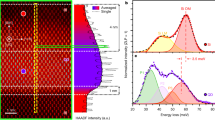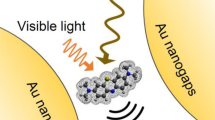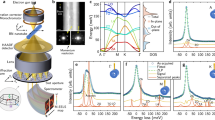Abstract
Imaging of vibrational excitations in and near nanostructures is essential for developing low-loss infrared nanophotonics1, controlling heat transport in thermal nanodevices2,3, inventing new thermoelectric materials4 and understanding nanoscale energy transport. Spatially resolved electron energy loss spectroscopy has previously been used to image plasmonic behaviour in nanostructures in an electron microscope5,6, but hitherto it has not been possible to map vibrational modes directly in a single nanostructure, limiting our understanding of phonon coupling with photons7 and plasmons8. Here we present spatial mapping of optical and acoustic, bulk and surface vibrational modes in magnesium oxide nanocubes using an atom-wide electron beam. We find that the energy and the symmetry of the surface polariton phonon modes depend on the size of the nanocubes, and that they are localized to the surfaces of the nanocube. We also observe a limiting of bulk phonon scattering in the presence of surface phonon modes. Most phonon spectroscopies are selectively sensitive to either surface or bulk excitations; therefore, by demonstrating the excitation of both bulk and surface vibrational modes using a single probe, our work represents advances in the detection and visualization of spatially confined surface and bulk phonons in nanostructures.
This is a preview of subscription content, access via your institution
Access options
Access Nature and 54 other Nature Portfolio journals
Get Nature+, our best-value online-access subscription
$29.99 / 30 days
cancel any time
Subscribe to this journal
Receive 51 print issues and online access
$199.00 per year
only $3.90 per issue
Buy this article
- Purchase on Springer Link
- Instant access to full article PDF
Prices may be subject to local taxes which are calculated during checkout




Similar content being viewed by others
References
Caldwell, J. D. et al. Low-loss, infrared and terahertz nanophotonics using surface phonon polaritons. Nanophotonics 4, 44–68 (2015)
Maldovan, M. Sound and heat revolutions in phononics. Nature 503, 209–217 (2013)
Venkatasubramanian, R., Siivola, E., Colpitts, T. & O’Quinn, B. Thin-film thermoelectric devices with high room-temperature figures of merit. Nature 413, 597–602 (2001)
Snyder, G. J. & Toberer, E. S. Complex thermoelectric materials. Nat. Mater. 7, 105–114 (2008)
Nelayah, J. et al. Mapping surface plasmons on a single metallic nanoparticle. Nat. Phys. 3, 348–353 (2007)
Nicoletti, O. et al. Three-dimensional imaging of localized surface plasmon resonances of metal nanoparticles. Nature 502, 80–84 (2013)
Hillenbrand, R., Taubner, T. & Keilmann, F. Phonon-enhanced light–matter interaction at the nanometre scale. Nature 418, 159–162 (2002)
Caldwell, J. D. et al. Atomic-scale photonic hybrids for mid-infrared and terahertz nanophotonics. Nat. Nanotechnol. 11, 9–15 (2016)
Geiger, J. Excitation of surface phonons (Fröhlich modes) by keV electrons in small magnesium oxide particles. J. Phys. Soc. Jpn 36, 615 (1974)
Genzeland, L. & Martin, T. P. Lattice dynamics of MgO microcrystals. Phys. Status Solidi (b) 51, 101–106 (1972)
Fuchs, R. Theory of the optical properties of ionic crystal cubes. Phys. Rev. B 11, 1732–1740 (1975)
Caldwell, J. D. et al. Low-loss, extreme subdiffraction photon confinement via silicon carbide localized surface phonon polariton resonators. Nano Lett. 13, 3690–3697 (2013)
Clark, J. N. et al. Ultrafast three-dimensional imaging of lattice dynamics in individual gold nanocrystals. Science 341, 56–59 (2013)
Wallis, R. F. Theory of surface modes of vibration in two- and three-dimensional crystal lattices. Phys. Rev. 116, 302–308 (1959)
Chalopin, Y. et al. Size-dependent infrared properties of MgO nanoparticles with evidence of screening effect. Appl. Phys. Lett. 100, 241904 (2012)
Krivanek, O. L. et al. Vibrational spectroscopy in the electron microscope. Nature 514, 209–212 (2014)
Batson, P. E., Delby, N. & Krivanek, O. L. Sub-ångström resolution using aberration-corrected electron optics. Nature 418, 617–620 (2002)
Glauber, R. J. Time-dependent displacement correlations and inelastic scattering by crystals. Phys. Rev. 98, 1692–1698 (1955)
Earney, J. J. Phonon scattering of fast electrons by crystals. Phil. Mag. 23, 577–583 (1971)
Rez, P. Is localized infrared spectroscopy now possible in the electron microscope? Microsc. Microanal. 20, 671–677 (2014)
Forbes, B. D. & Allen, L. Modeling energy-loss spectra due to phonon excitation. Phys. Rev. B 94, 014110 (2016)
Peckham, G. The phonon dispersion relation for magnesium oxide. Proc. Phys. Soc. 90, 657–670 (1967)
Sangster, M. J. L., Peckham, G. & Saunderson, D. H. Lattice dynamics of magnesium oxide. J. Phys. C 3, 1026–1036 (1970)
Ibach, H . & Mills, D. L. Electron Energy Loss Spectroscopy and Surface Vibrations 1st edn (Academic Press, 1982)
Pines, D. & Nozieres, P. Theory of Quantum Liquids 1st edn, Ch. 2 (Academic Press, 1966)
Ritchie, R. H. Plasma losses by fast electrons in thin films. Phys. Rev. 106, 874–881 (1957)
Fuchs, R. & Kliewer, K. L. Optical modes of vibration in an ionic crystal slab. Phys. Rev. 140, A2076–A2088 (1965)
Oshima, C., Aizawa, T., Souda, R. & Ishizawa, Y. Microscopic surface phonons of MgO (100) surface. Solid State Commun. 73, 731–734 (1990)
Hohenester, U. & Trügler, A. MNPBEM – a Matlab toolbox for the simulation of plasmonic nanoparticles. Comput. Phys. Commun. 183, 370–381 (2012)
Ferrari, A. C. & Robertson, J. Interpretation of Raman spectra of disordered and amorphous carbon. Phys. Rev. B 61, 14095–14107 (2000)
Marks, L. D. Observation of the image force for fast electrons near an MgO surface. Solid State Commun. 43, 727–729 (1982)
Senet, P., Lambin, Ph., Vigneron, J. P., Derycke, I. & Lucas, A. A. Phonon surface function of ionic-crystal films: a comparison between microscopic and macroscopic approaches. Surf. Sci. 226, 307–321 (1990)
Lambin, Ph., Senet, P. & Lucas, A. A. Validity of the dielectric approximation in describing electron-energy-loss spectra of surface and interface phonons in thin films of ionic crystals. Phys. Rev. B 44, 6416–6428 (1991)
García de Abajo, F. J. Optical excitations in electron microscopy. Rev. Mod. Phys. 82, 209–275 (2010)
Boudarham, G. & Kociak, M. Modal decompositions of the local electromagnetic density of states and spatially resolved electron energy loss probability in terms of geometric modes. Phys. Rev. B 85, 245447 (2012)
Li, C. H., Tong, S. Y. & Mills, D. L. Large-angle inelastic electron scattering from adsorbate vibrations: basic theory. Phys. Rev. B 21, 3057–3073 (1980)
Matsui, M. Molecular dynamics study of the structural and thermodynamic properties of MgO crystal with quantum correction. J. Chem. Phys. 91, 489 (1989)
Dwyer, C. Localization of high-energy electron scattering from atomic vibrations. Phys. Rev. B 89, 054103 (2014)
Saavedra, J. R. M. & Garcia de Abajo, F. J. Phonon excitation by electron beams in nanographenes. Phys. Rev. B 92, 115449 (2015)
Acknowledgements
P.E.B. and M.J.L. acknowledge the financial support of US Department of Energy, Office of Science, Basic Energy Sciences under award number DE-SC0005132. U.H. and A.T. acknowledge the support of the Austrian Science Fund FWF under project P27299-N27 and the SFB F49 NextLite (F4906-N23). We acknowledge O. Krivanek, N. Dellby, T. Lovejoy, M. Saharan and C. Meyer for discussions on the microscope instrumentation/operation and for help with the software development for microscopy data acquisition.
Author information
Authors and Affiliations
Contributions
M.J.L. initiated the project and conceived the experiments. M.J.L. prepared the samples and conducted the EELS-STEM experiments. M.J.L. and P.E.B. performed the data analysis and interpretation. U.H. and A.T. developed the theoretical model and performed the theoretical calculations. M.J.L. and P.E.B. wrote the manuscript. All authors read and commented on the manuscript.
Corresponding author
Ethics declarations
Competing interests
The authors declare no competing financial interests.
Additional information
Reviewer Information Nature thanks C. Colliex, P. Rez and the other anonymous reviewer(s) for their contribution to the peer review of this work.
Publisher's note: Springer Nature remains neutral with regard to jurisdictional claims in published maps and institutional affiliations.
Extended data figures and tables
Extended Data Figure 1 Excitation of corner, face and edge SPhP modes in approximately 150-nm MgO cubes.
The excitation occurs in the aloof geometry and the probe positions are indicated by dots in the ADF images (see insets of a, c and e). a, c, e, Experimental EELS spectra for cubes oriented along the [001], [111] and [110] directions, respectively. b, d, f, Simulated EELS probabilities (dotted lines) corresponding to the configurations shown in a, c and e, respectively. The continuous lines are theoretical curves that correspond to the convolution of the dotted lines with a Gaussian function with a width of 10 meV, which accounts for the instrument response. Excitation of the corner mode (red curves) shows up as a peak at approximately 69 meV (vertical dashed red lines in a, c and e). The face-mode excitation (green curves) appears as an asymmetric peak at approximately 78 meV (vertical dashed green line in a). This asymmetry is introduced by low-energy contributions of the corner and edge modes. The edge-mode excitation (blue curves) appears as an asymmetric peak at approximately 72 meV (vertical dashed blue line in e). Good agreement between the theoretical convoluted curves (b, d, f) and the experimental results (a, c, e) is obtained.
Extended Data Figure 2 Scattering coupling factor between the swift electron and the phonon modes of a bulk MgO crystal.
See Methods. The phonon dispersions (light grey curves) were determined using the rigid-ion approach and most of the calculated phonon frequencies exhibit excellent agreement with the experimental data. The dispersion curves exhibit the typical optical (LO, TO) and acoustic (LA, TA) modes across the first Brillouin zone. The strength of the coupling is represented by the size of the red circles (proportional to qFλ(q)), which are superposed over the light grey phonon dispersion lines, with larger circles indicating stronger coupling. The swift electron can couple very efficiently to the LO and LA modes, while the transverse modes display weak coupling. An effective coupling can occur with short-wavelength phonons close to the Brillouin zone boundaries through high-angle scattering events.
Extended Data Figure 3 Simulated EELS probabilities for cubes of different sizes, considering an electron probe in the aloof geometry in the middle of the cube face (5 nm away from the surface).
At this location, the probe is able to excite corner, edge and face SPhP modes with different probabilities, as shown in Extended Data Fig. 1b (green curve). The probabilities were normalized with respect to the intensity maximum of the corner resonance (about 71 meV). For the small cubes, the corner mode dominates the excitation spectrum, resulting in small probabilities of face-mode excitations.
Supplementary information
Phonon Mapping 100nm MgOcube
Video showing experimental phonon EELS maps acquired on the edge of a suspended 100 nm MgO cube. Each snapshot represents a phonon map generated at certain energy. Note the surface phonon modes (~ 70 and 77 meV) are highly localized close to corner and face of the cube, respectively. Their scattering intensities can extend towards the vacuum. The bulk modes (~ 40, 50 and 88 meV) remain confined within the cube. The dotted line indicated the edge of the nanocube. (MP4 1118 kb)
Rights and permissions
About this article
Cite this article
Lagos, M., Trügler, A., Hohenester, U. et al. Mapping vibrational surface and bulk modes in a single nanocube. Nature 543, 529–532 (2017). https://doi.org/10.1038/nature21699
Received:
Accepted:
Published:
Issue Date:
DOI: https://doi.org/10.1038/nature21699
This article is cited by
-
Single-atom vibrational spectroscopy with chemical-bonding sensitivity
Nature Materials (2023)
-
μeV electron spectromicroscopy using free-space light
Nature Communications (2023)
-
Machine learning in scanning transmission electron microscopy
Nature Reviews Methods Primers (2022)
-
Alignment-invariant signal reality reconstruction in hyperspectral imaging using a deep convolutional neural network architecture
Scientific Reports (2022)
-
Isotopes tracked on a sub-nanometre scale using electron spectroscopy
Nature (2022)
Comments
By submitting a comment you agree to abide by our Terms and Community Guidelines. If you find something abusive or that does not comply with our terms or guidelines please flag it as inappropriate.



